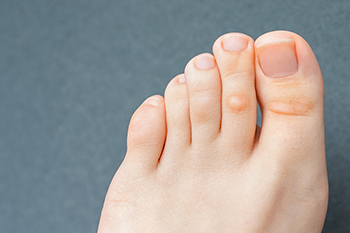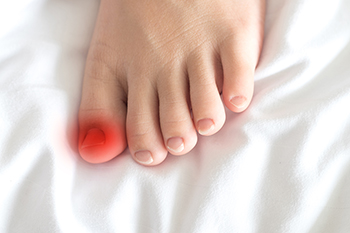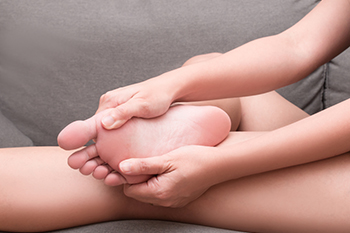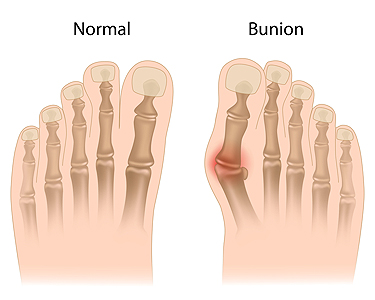Items filtered by date: July 2022
Wounds That Don't Heal Need to Be Checked
Removing Corns on the Feet

Corns are hard, callus-like growths that can develop on your feet. They usually develop in response to repeated pressure applied to a point on the foot, usually from ill-fitting or tight footwear. If you have corns on your feet, you should consult with a podiatrist to address the problem in the best possible way. In some cases, you might be able to remove the corn with a few at-home remedies. However, those with diabetes, circulatory disorders, and certain other conditions should never attempt to treat a corn by themselves. The most common way to remove corns involves soaking the feet in warm water for approximately ten minutes. This is done to soften the affected skin on the feet. After this step, you may be able to gently file down the outer layers of the corn by using a pumice stone or an emery board. However, it is important not to file excessively because you might end up injuring the deeper layers of the skin. There are also a variety of over-the-counter products that you might find useful in attempting to remove the corn on your feet. For example, you can use products such as lotions or scrubs that contain salicylic acid. This acid works to break down the corn. When in doubt, it is best to contact a trusted podiatrist who can help you determine the best way for the corn to be removed.
If you have any concerns regarding your feet and ankles, contact the foot specialists of Table Mountain Foot and Ankle. Our doctors will treat your foot and ankle needs.
Corns: What Are They? and How Do You Get Rid of Them?
Corns can be described as areas of the skin that have thickened to the point of becoming painful or irritating. They are often layers and layers of the skin that have become dry and rough, and are normally smaller than calluses.
Ways to Prevent Corns
There are many ways to get rid of painful corns such as wearing:
- Well-fitting socks
- Comfortable shoes that are not tight around your foot
- Shoes that offer support
Treating Corns
Treatment of corns involves removing the dead skin that has built up in the specific area of the foot. Consult with Our doctors to determine the best treatment option for your case of corns.
If you have any questions please feel free to contact our office located in Wheat Ridge, CO . We offer the newest diagnostic and treatment technologies for all your foot and ankle needs.
Probable Causes for an Ingrown Toenail

An ingrown toenail is a common foot condition. It occurs as a result of the skin growing into the sides of the nail instead of over it. The symptoms that are generally associated with this ailment often include extreme tenderness, swelling, and is often painful. The big toe is typically affected by an ingrown toenail, although it can affect the other toes. In severe cases, the affected toe may produce a discharge, and can become infected. Ingrown toenails can happen for a variety of reasons. These can include wearing shoes that do not fit correctly, incurring a toe injury, or possibly from genetic reasons. Additionally, it may come from trimming the toenails incorrectly. Relief can come from soaking the toe in warm water, followed by gently pulling the skin away from the nail. If the ingrown toenail is severe, surgery may have to be performed that can remove part of the nail, or the entire nail. It is important to wear shoes that are comfortable, and fit correctly, and it is beneficial to refrain from wearing tight socks. If you are afflicted with an ingrown toenail, please consult with a podiatrist as quickly as possible who can recommend the right treatment for you.
Ingrown toenails can become painful if they are not treated properly. For more information about ingrown toenails, contact the foot specialists of Table Mountain Foot and Ankle. Our doctors can provide the care you need to keep you pain-free and on your feet.
Ingrown Toenails
Ingrown toenails occur when a toenail grows sideways into the bed of the nail, causing pain, swelling, and possibly infection.
Causes
- Bacterial infections
- Improper nail cutting such as cutting it too short or not straight across
- Trauma to the toe, such as stubbing, which causes the nail to grow back irregularly
- Ill-fitting shoes that bunch the toes too close together
- Genetic predisposition
Prevention
Because ingrown toenails are not something found outside of shoe-wearing cultures, going barefoot as often as possible will decrease the likeliness of developing ingrown toenails. Wearing proper fitting shoes and using proper cutting techniques will also help decrease your risk of developing ingrown toenails.
Treatment
Ingrown toenails are a very treatable foot condition. In minor cases, soaking the affected area in salt or antibacterial soaps will not only help with the ingrown nail itself, but also help prevent any infections from occurring. In more severe cases, surgery is an option. In either case, speaking to your podiatrist about this condition will help you get a better understanding of specific treatment options that are right for you.
If you have any questions please feel free to contact our office located in Wheat Ridge, CO . We offer the newest diagnostic and treatment technologies for all your foot and ankle needs.
Sesamoiditis: A Common Running Injury

Sesamoiditis is an injury that affects many runners, particularly those who train on hard surfaces or rocks. Sesamoiditis occurs when the two tiny sesamoid bones that reside under the big toe get fractured and/or the tendons around the sesamoids become irritated and inflamed. Sesamoiditis may occur from the repeated impact a runner’s foot makes with the ground, or from other factors such as having tight toe flexors. Pain from sesamoiditis can be sharp and sudden, and is usually felt underneath the big toe or in the ball of the foot. If it feels like a burning pain, this may indicate nerve damage. A podiatrist can treat sesamoiditis with recommendations of rest, along with prescribing anti-inflammatory medications and reducing inflammation with other methods.
Sesamoiditis is an unpleasant foot condition characterized by pain in the balls of the feet. If you think you’re struggling with sesamoiditis, contact the foot specialists of Table Mountain Foot and Ankle. Our doctors will treat your condition thoroughly and effectively.
Sesamoiditis
Sesamoiditis is a condition of the foot that affects the ball of the foot. It is more common in younger people than it is in older people. It can also occur with people who have begun a new exercise program, since their bodies are adjusting to the new physical regimen. Pain may also be caused by the inflammation of tendons surrounding the bones. It is important to seek treatment in its early stages because if you ignore the pain, this condition can lead to more serious problems such as severe irritation and bone fractures.
Causes of Sesamoiditis
- Sudden increase in activity
- Increase in physically strenuous movement without a proper warm up or build up
- Foot structure: those who have smaller, bonier feet or those with a high arch may be more susceptible
Treatment for sesamoiditis is non-invasive and simple. Doctors may recommend a strict rest period where the patient forgoes most physical activity. This will help give the patient time to heal their feet through limited activity. For serious cases, it is best to speak with your doctor to determine a treatment option that will help your specific needs.
If you have any questions please feel free to contact our office located in Wheat Ridge, CO . We offer the newest diagnostic and treatment technologies for all your foot and ankle needs.
How Runners Can Address Troublesome Bunions
 Running is one of the most popular and widespread forms of exercise. Yet, bunions can often make this activity challenging or even painful. There are a variety of ways that individuals can manage the effects of bunions and continue to run. Bunions are bumps that occur usually on the base of the big toe when the metatarsophalangeal joint is stressed and strained. In some cases, bunions may form at the base of the pinky toe as well. If a runner has developed a bunion that is not causing serious pain, the runner may be able to continue running with wider footwear. Opting for wider running shoes can decrease the extent to which the bunion rubs up against the shoe and further aggravates or inflames the bump. Another way that runners may cope with bunions is by applying ice to the affected area for a short duration of time following the run. Toe spacers and bunion pads may also prove to be useful for runners looking to manage the annoyance of bunions. Bunions are certainly not ideal for runners, but a podiatrist may be able to help you address the affliction and get back on the running trail comfortably again.
Running is one of the most popular and widespread forms of exercise. Yet, bunions can often make this activity challenging or even painful. There are a variety of ways that individuals can manage the effects of bunions and continue to run. Bunions are bumps that occur usually on the base of the big toe when the metatarsophalangeal joint is stressed and strained. In some cases, bunions may form at the base of the pinky toe as well. If a runner has developed a bunion that is not causing serious pain, the runner may be able to continue running with wider footwear. Opting for wider running shoes can decrease the extent to which the bunion rubs up against the shoe and further aggravates or inflames the bump. Another way that runners may cope with bunions is by applying ice to the affected area for a short duration of time following the run. Toe spacers and bunion pads may also prove to be useful for runners looking to manage the annoyance of bunions. Bunions are certainly not ideal for runners, but a podiatrist may be able to help you address the affliction and get back on the running trail comfortably again.
If you are suffering from bunions, contact the foot specialists of Table Mountain Foot and Ankle. Our doctors can provide the care you need to keep you pain-free and on your feet.
What Is a Bunion?
A bunion is formed of swollen tissue or an enlargement of boney growth, usually located at the base joint of the toe that connects to the foot. The swelling occurs due to the bones in the big toe shifting inward, which impacts the other toes of the foot. This causes the area around the base of the big toe to become inflamed and painful.
Why Do Bunions Form?
Genetics – Susceptibility to bunions are often hereditary
Stress on the feet – Poorly fitted and uncomfortable footwear that places stress on feet, such as heels, can worsen existing bunions
How Are Bunions Diagnosed?
Doctors often perform two tests – blood tests and x-rays – when trying to diagnose bunions, especially in the early stages of development. Blood tests help determine if the foot pain is being caused by something else, such as arthritis, while x-rays provide a clear picture of your bone structure to your doctor.
How Are Bunions Treated?
- Refrain from wearing heels or similar shoes that cause discomfort
- Select wider shoes that can provide more comfort and reduce pain
- Anti-inflammatory and pain management drugs
- Orthotics or foot inserts
- Surgery
If you have any questions, please feel free to contact our office located in Wheat Ridge, CO . We offer the newest diagnostic and treatment technologies for all your foot care needs.

